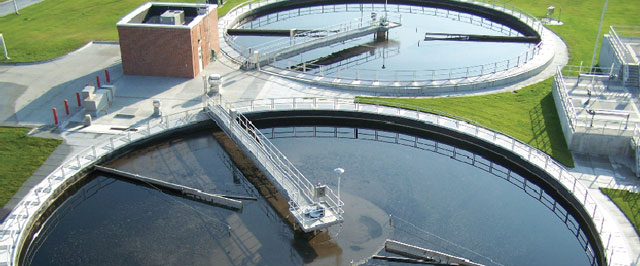Rhode Island Finances Municipal Wastewater Adaptation Efforts to Minimize Climate Risk

The historic flooding of the Pawtuxet, Pawcatuck, and Blackstone Rivers in 2010 caused widespread damage to Rhode Island’s wastewater treatment infrastructure, inundating two of its 19 wastewater treatment facilities and partially flooding another facility. At the same time, many of Rhode Island’s pumping stations, which help collect and transport wastewater, became inoperable.
Not only is riverine flooding likely to occur with increased severity and frequency in the future, but coastal flooding from major storm events could also damage many of Rhode Island’s 14 wastewater treatment facilities along the shoreline. In response to these growing concerns, the Rhode Island Department of Environmental Management (RIDEM) recognized the need to enhance the resilience of the wastewater infrastructure to the risks posed by extreme weather hazards and impacts.
To inform and enable financial investment in the resilience of Rhode Island’s wastewater treatment infrastructure, RIDEM sought to better understand the risks from extreme weather and natural disasters faced by individual wastewater treatment facilities and establish a financing mechanism for reducing these risks. RIDEM began this effort by publishing the report, Implications of Climate Change for RI Wastewater Collection & Treatment Infrastructure, in 2017. This study assessed each wastewater treatment facility in the state, identified their vulnerabilities to extreme weather-related impacts, and developed adaptive strategies to minimize these vulnerabilities.
These facility-level assessments incorporate projections of extreme weather and natural disasters over time including:
- Sea level rise.
- Shoreline change.
- Coastal and riverine hazards.
- Data on how weather events affected the State’s wastewater treatment facilities in the past.
Based on these data, RIDEM identified the top three climate-amplified hazards for each individual facility and recommended adaptation strategies to address these risks (e.g., hardening, relocation, replacement/repair of individual systems, and redundancy).
Following the release of the facility-level vulnerability assessments, RIDEM announced the creation of the Wastewater Treatment Facility Resilience Fund (WWTFRF) in 2019 to help Rhode Island’s wastewater treatment plants finance the adaptation measures recommended by each facility-level assessment. Proceeds from Rhode Island’s Green Economy and Clean Water Bond, which was approved by voters in 2018, supported the $5 million fund. The WWTFRF sought proposals for projects that would “harden, relocate, repair/replace, and/or provide redundancy to government-owned wastewater treatment facilities (and/or critical equipment/components within) to protect these facilities from hazards/impacts related to" extreme weather and/or natural disasters.
Eligibility for funding included any government-owned wastewater treatment facilities in the state, but not stormwater and drinking water facilities. The WWTFRF encouraged municipalities interested in receiving WWTFRF funds to examine the 2017 vulnerability assessments to inform the development of their applications.
The WWTFRF awarded 50% matching grants, with the funding divided into two sub-funds:
- The “small projects sub-fund,” providing up to $250,000 for projects estimated to cost $500,000 or less.
- The “large projects sub-fund,” providing up to $1,250,000 for all other projects.
The Rhode Island Infrastructure Bank helped finance some of the grantees’ matches, particularly for the grant’s largest awards.
In April 2020, RIDEM awarded $4.7 million in matching grants to fund wastewater treatment facility resilience projects in 15 municipalities across the state. The projects included:
- Upgrades to protect facilities from flooding, such as installing flood-proof pumps and elevating or relocating structures and components.
- Installing emergency generators to allow facilities to continue running during storm-induced power outages.
- Constructing grit-removal systems to protect facilities from increased sediment flows during intense rainfall events.
Rhode Island’s two-pronged vulnerability assessment and funding approach provided municipalities with the information they need to better focus their adaptation efforts and the financial resources critical to implementing these strategies. Ultimately, by combining statewide matching grant funding with wastewater treatment facility vulnerability assessments, Rhode Island provided adaptation funding outside of the federal financing mechanisms often used for wastewater treatment systems and reduced the technical and financial burden on its municipalities to address their extreme weather and natural disaster vulnerabilities.
|
How Did They Do It? |
Applicable Tools |
|---|---|
|
Conducted an impacts study What the implications of extreme weather events could mean for RI Wastewater Collection and Treatment Infrastructure |
Tools used: Plant Operators Questionnaire (see Appendix A) was used to collect wastewater facility-specific data. STORMTOOLS mapping tool was used to assess coastal flood hazards and analyze coastal erosion in Rhode Island. FEMA's Wave Height Analysis for Flood Insurance Studies model and guidance from the Federal Flood Risk Management Standard Support Tool were used to assess wave and riverine flood hazards. Additional tools that may be useful: NOAA’s Coastal Flood Exposure Mapper assesses coastal flood hazards nationwide. |
|
Established the Wastewater Treatment Facility Resilience Fund
|
Tools used: The 2018 Green Economy & Clean Water Bond allowed Rhode Island to secure funding to enhance wastewater treatment facility resilience to extreme weather events and commit funds to other adaptation investments across the state. Additional tools that may be useful: EPA's Water Infrastructure and Resiliency Finance Center provides financing information to help communities make informed decisions on drinking water, wastewater, and stormwater infrastructure to protect human health and the environment. |
Similar Cases and More Information
See how Boston and Washington, DC addressed vulnerability to sea level rise and riverine flooding at their wastewater facilities:
- Boston Raises Wastewater Facility to Avoid Inundation
- Blue Plains Wastewater Facility in Washington DC Reinforces Facility Against Floods
References
- Wastewater Treatment Facility Resilience Fund (Rhode Island Department of Environmental Management)
- 2018 Green Economy & Clean Water Bond (Rhode Island Department of Environmental Management)
- Implications of Climate Change for RI Wastewater Collection & Treatment Infrastructure (Rhode Island Department of Environmental Management)
- Rules and Regulations for the Wastewater Treatment Facility Resiliency Fund (Rhode Island Department of State)
- DEM, Infrastructure Bank Award $4.7 Million to Strengthen Resilience of Wastewater Collection and Treatment Infrastructure (State of Rhode Island)
